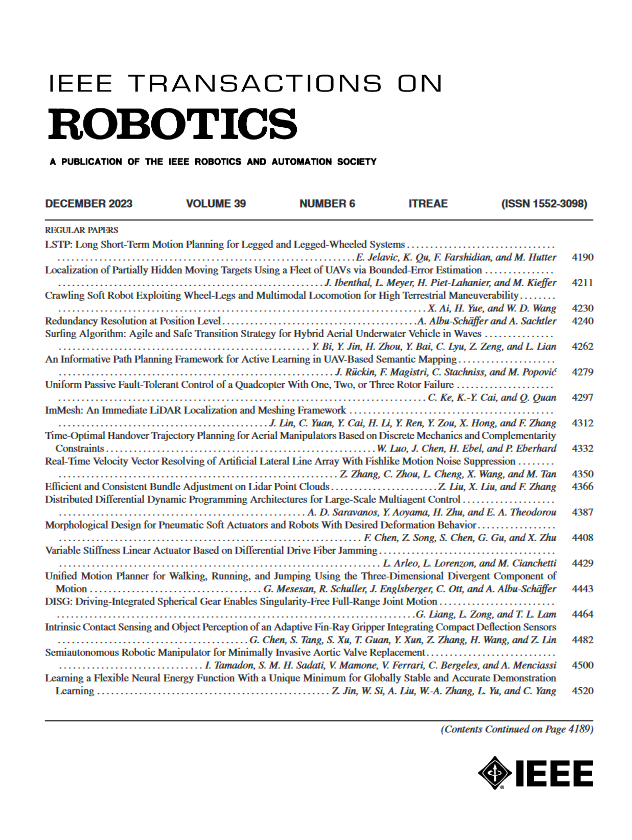Structure-Exploiting Sequential Quadratic Programming for Model-Predictive Control
IF 10.5
1区 计算机科学
Q1 ROBOTICS
引用次数: 0
Abstract
The promise of model-predictive control (MPC) in robotics has led to extensive development of efficient numerical optimal control solvers in line with differential dynamic programming because it exploits the sparsity induced by time. In this work, we argue that this effervescence has hidden the fact that sparsity can be equally exploited by standard nonlinear optimization. In particular, we show how a tailored implementation of sequential quadratic programming (QP) achieves state-of-the-art MPC. Then, we clarify the connections between popular algorithms from the robotics community and well-established optimization techniques. Further, the sequential quadratic program formulation naturally encompasses the constrained case, a notoriously difficult problem in the robotics community. Specifically, we show that it only requires a sparsity-exploiting implementation of a state-of-the-art QP solver. We illustrate the validity of this approach in a comparative study and experiments on a torque-controlled manipulator. To the best of our knowledge, this is the first demonstration of closed loop nonlinear MPC with constraints on a real robot.基于结构的序列二次规划模型预测控制
模型预测控制(MPC)在机器人领域的应用前景,导致了基于微分动态规划的高效数值最优控制求解器的广泛发展,因为它利用了由时间引起的稀疏性。在这项工作中,我们认为这种泡沫隐藏了这样一个事实,即稀疏性可以被标准非线性优化同样利用。特别是,我们展示了顺序二次规划(QP)的定制实现如何实现最先进的MPC。然后,我们澄清了机器人社区流行算法与成熟优化技术之间的联系。此外,顺序二次规划公式自然地包含了约束情况,这是机器人社区中众所周知的难题。具体来说,我们表明它只需要利用最先进的QP求解器的稀疏性实现。我们在力矩控制机械臂的对比研究和实验中说明了这种方法的有效性。据我们所知,这是第一次在真实机器人上演示具有约束的闭环非线性MPC。
本文章由计算机程序翻译,如有差异,请以英文原文为准。
求助全文
约1分钟内获得全文
求助全文
来源期刊

IEEE Transactions on Robotics
工程技术-机器人学
CiteScore
14.90
自引率
5.10%
发文量
259
审稿时长
6.0 months
期刊介绍:
The IEEE Transactions on Robotics (T-RO) is dedicated to publishing fundamental papers covering all facets of robotics, drawing on interdisciplinary approaches from computer science, control systems, electrical engineering, mathematics, mechanical engineering, and beyond. From industrial applications to service and personal assistants, surgical operations to space, underwater, and remote exploration, robots and intelligent machines play pivotal roles across various domains, including entertainment, safety, search and rescue, military applications, agriculture, and intelligent vehicles.
Special emphasis is placed on intelligent machines and systems designed for unstructured environments, where a significant portion of the environment remains unknown and beyond direct sensing or control.
 求助内容:
求助内容: 应助结果提醒方式:
应助结果提醒方式:


